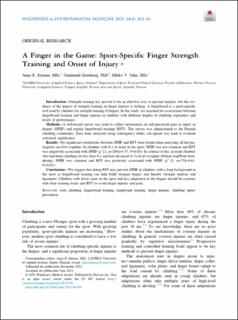| dc.contributor.author | Sjöman, Anna E. | |
| dc.contributor.author | Grønhaug, Gudmund | |
| dc.contributor.author | Julin, Mikko V. | |
| dc.date.accessioned | 2024-01-09T08:02:28Z | |
| dc.date.available | 2024-01-09T08:02:28Z | |
| dc.date.created | 2023-09-07T09:25:49Z | |
| dc.date.issued | 2023 | |
| dc.identifier.citation | Wilderness & environmental medicine (Print). 2023, . | en_US |
| dc.identifier.issn | 1080-6032 | |
| dc.identifier.uri | https://hdl.handle.net/11250/3110489 | |
| dc.description.abstract | Introduction: Strength training has proved to be an effective way to prevent injuries, but the evidence of the impact of strength training on finger injuries is lacking. A fingerboard is a sport-specific tool used by climbers for strength training of fingers. In this study, we searched for associations between fingerboard training and finger injuries in climbers with different lengths of climbing experience and levels of performance. Methods: A web-based survey was used to collect information on self-perceived pain or injury in fingers (SPIIF) and regular fingerboard training (RFT). The survey was administered to the Finnish climbing community. Data were analyzed using contingency tables; chi-square was used to evaluate statistical significance. Results: No significant correlations between SPIIF and RFT were found when analyzing all the participants (n=434) together. In climbers with 6 y or more in the sport, SPIIF was not common and RFT was negatively associated with SPIIF (χ2 [1, n=200]=4.57; P=0.03). In contrast to this, in male climbers who had been climbing for less than 6 y and had advanced to 7a level or higher (French lead/Font bouldering), SPIIF was common and RFT was positively associated with SPIIF (χ2 [1, n=75]=4.61; P=0.03). Conclusions: We suggest that doing RFT may prevent SPIIF in climbers with a long background in the sport as fingerboard training can help build stronger fingers and thereby stronger tendons and ligaments. Climbers with fewer years in the sport and less adaptation to the fingers should be cautious with their training loads and RFT to avoid finger injuries and pain. | en_US |
| dc.language.iso | eng | en_US |
| dc.publisher | Elsevier | en_US |
| dc.rights | Navngivelse 4.0 Internasjonal | * |
| dc.rights.uri | http://creativecommons.org/licenses/by/4.0/deed.no | * |
| dc.title | A Finger in the Game: Sport-Specific Finger Strength Training and Onset of Injury | en_US |
| dc.type | Peer reviewed | en_US |
| dc.type | Journal article | en_US |
| dc.description.version | publishedVersion | en_US |
| dc.rights.holder | © 2023 Wilderness Medical Society | en_US |
| dc.source.pagenumber | 435-441 | en_US |
| dc.source.volume | 34 | en_US |
| dc.source.journal | Wilderness & environmental medicine (Print) | en_US |
| dc.source.issue | 4 | en_US |
| dc.identifier.doi | 10.1016/j.wem.2023.06.004 | |
| dc.identifier.cristin | 2173087 | |
| cristin.ispublished | true | |
| cristin.fulltext | original | |
| cristin.qualitycode | 1 | |

